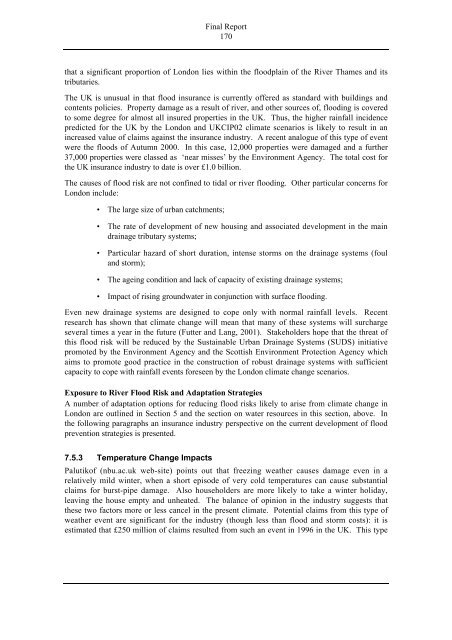London scoping - ukcip
London scoping - ukcip
London scoping - ukcip
You also want an ePaper? Increase the reach of your titles
YUMPU automatically turns print PDFs into web optimized ePapers that Google loves.
Final Report<br />
170<br />
that a significant proportion of <strong>London</strong> lies within the floodplain of the River Thames and its<br />
tributaries.<br />
The UK is unusual in that flood insurance is currently offered as standard with buildings and<br />
contents policies. Property damage as a result of river, and other sources of, flooding is covered<br />
to some degree for almost all insured properties in the UK. Thus, the higher rainfall incidence<br />
predicted for the UK by the <strong>London</strong> and UKCIP02 climate scenarios is likely to result in an<br />
increased value of claims against the insurance industry. A recent analogue of this type of event<br />
were the floods of Autumn 2000. In this case, 12,000 properties were damaged and a further<br />
37,000 properties were classed as ‘near misses’ by the Environment Agency. The total cost for<br />
the UK insurance industry to date is over £1.0 billion.<br />
The causes of flood risk are not confined to tidal or river flooding. Other particular concerns for<br />
<strong>London</strong> include:<br />
The large size of urban catchments;<br />
The rate of development of new housing and associated development in the main<br />
drainage tributary systems;<br />
Particular hazard of short duration, intense storms on the drainage systems (foul<br />
and storm);<br />
The ageing condition and lack of capacity of existing drainage systems;<br />
Impact of rising groundwater in conjunction with surface flooding.<br />
Even new drainage systems are designed to cope only with normal rainfall levels. Recent<br />
research has shown that climate change will mean that many of these systems will surcharge<br />
several times a year in the future (Futter and Lang, 2001). Stakeholders hope that the threat of<br />
this flood risk will be reduced by the Sustainable Urban Drainage Systems (SUDS) initiative<br />
promoted by the Environment Agency and the Scottish Environment Protection Agency which<br />
aims to promote good practice in the construction of robust drainage systems with sufficient<br />
capacity to cope with rainfall events foreseen by the <strong>London</strong> climate change scenarios.<br />
Exposure to River Flood Risk and Adaptation Strategies<br />
A number of adaptation options for reducing flood risks likely to arise from climate change in<br />
<strong>London</strong> are outlined in Section 5 and the section on water resources in this section, above. In<br />
the following paragraphs an insurance industry perspective on the current development of flood<br />
prevention strategies is presented.<br />
7.5.3 Temperature Change Impacts<br />
Palutikof (nbu.ac.uk web-site) points out that freezing weather causes damage even in a<br />
relatively mild winter, when a short episode of very cold temperatures can cause substantial<br />
claims for burst-pipe damage. Also householders are more likely to take a winter holiday,<br />
leaving the house empty and unheated. The balance of opinion in the industry suggests that<br />
these two factors more or less cancel in the present climate. Potential claims from this type of<br />
weather event are significant for the industry (though less than flood and storm costs): it is<br />
estimated that £250 million of claims resulted from such an event in 1996 in the UK. This type

















